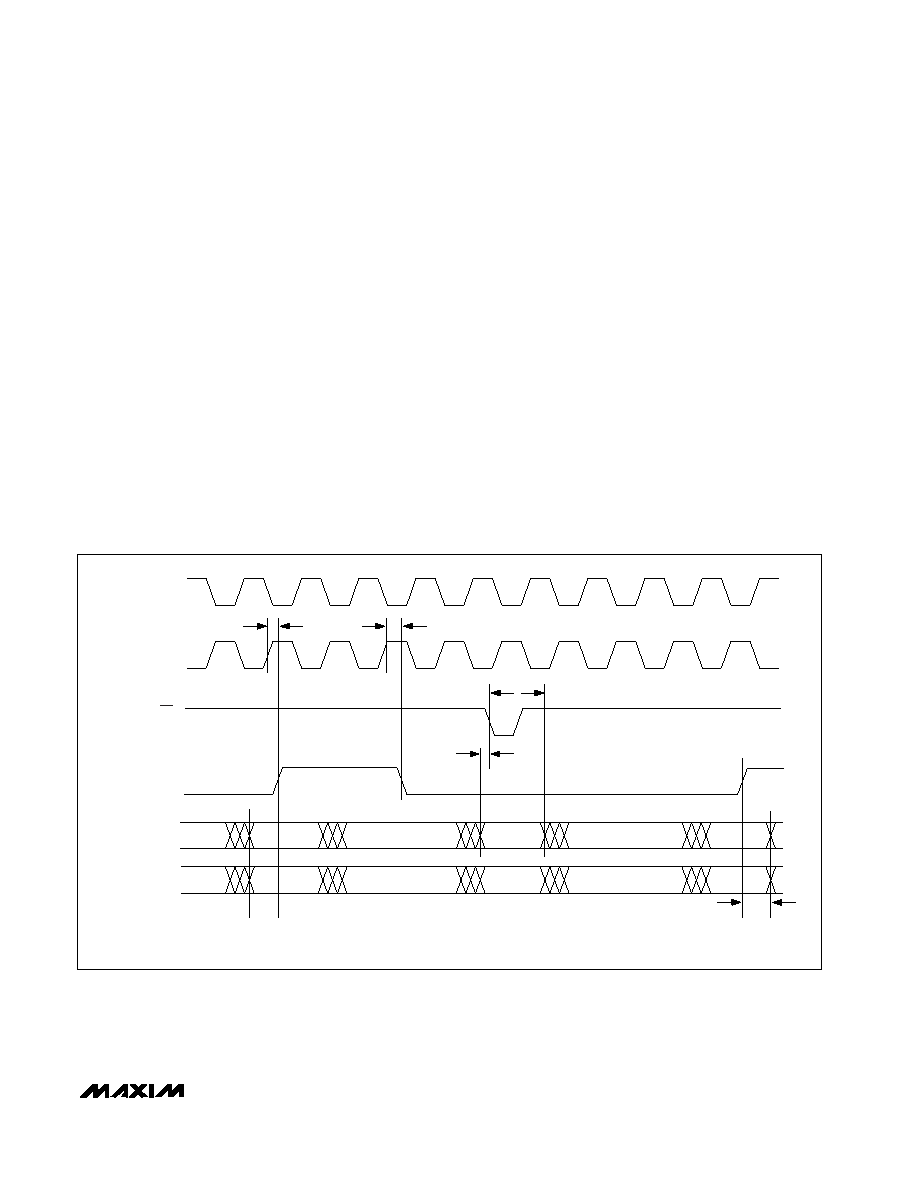- 您现在的位置:买卖IC网 > Sheet目录2011 > MAX5856AECM+D (Maxim Integrated Products)IC DAC 8BIT DUAL 300MSPS 48-TQFP

MAX5856A
Dual 8-Bit, 300Msps DAC with 4x/2x/1x
Interpolation Filters and PLL
______________________________________________________________________________________
19
CLKXP
1
CLK
DA0–DA7/
CONTROL WORD
tCXD
tDCSR
tDCHR
DAN
DBN
CONTROL WORD
DAN+1
DBN+1
1. CLKXP AND CLKXN MUST BE PRESENT ONLY WHEN PLL IS DISABLED, WITH PLLEN CONNECTED TO GND. THE DIAGRAM SHOWS 4x INTERPOLATION.
2. CLK IS AN OUTPUT WHEN PLL IS DISABLED, WITH PLLEN CONNECTED TO GND; OTHERWISE, IT IS AN INPUT.
CLKXN
1
tCWH
DB0–DB7
CW
tCXD
tCWS
Figure 6. Timing Diagram for Noninterleave Data Mode (IDE = Low)
Figure 6 illustrates the DAC write cycle in 4x interpola-
tion mode. With the interpolation feature enabled, the
device can operate with the PLL enabled or disabled.
To obtain best phase noise performance, disable the
PLL and keep the capacitive load at the CLK output low
(10pF or less at fDAC = 165MHz).
With the PLL disabled (PLLEN = 0), the clock signal is
applied to CLKXP/CLKXN and internally divided by 4 to
generate the DAC’s CLK signal. The CLK signal is a
divide-by-4 output, used to synchronize data into the
MAX5856A data ports. The CLKXP/CLKXN signal dri-
ves the interpolation filters and DAC cores at the
desired conversion rate.
If the PLL is enabled (PLLEN = 1), then CLK becomes
an input and the clock signal may be applied to CLK. In
Figure 6, the CLK signal is multiplied by a factor of four
by the PLL and distributed to the interpolation filters
and DAC cores. In this mode, CLKXP must be pulled
low and CLKXN pulled high.
The MAX5856A can operate with a single-ended clock
input used as both data clock and conversion clock. To
operate the device in this mode, disable the interpolation
filters and enable the PLL (PLLEN = 1). Apply a single-
ended clock input at CLK. The CLK signal acts as the
data synchronization clock and DAC core conversion
clock. Though the PLL is enabled, the lock pin (LOCK) is
not valid and the PLL is internally disconnected from the
interpolating filters and DAC cores. In this mode, CLKXP
must be pulled low and CLKXN pulled high.
Figure 6 shows the timing for the CW. An 8-bit control
word routed through channel A’s data port programs
the gain matching, interpolator configuration, and oper-
ational mode of the MAX5856A. The control word is
latched on the falling edge of CW. The CW signal is
asynchronous with conversion clocks CLK and
CLKXN/CLKXP; therefore, the conversion clock (CLK or
CLKXN/CLKXP) can run uninterrupted when a control
word is written to the device.
发布紧急采购,3分钟左右您将得到回复。
相关PDF资料
MAX5858AECM+D
IC DAC 10BIT DUAL 300MSPS 48TQFP
MAX5858ECM+D
IC DAC 10BIT DUAL 300MSPS 48TQFP
MAX5863ETM+T
IC AFE 8/10BIT 7.5MSPS 48-TQFN
MAX5864ETM+T
IC ANLG FRONT END 22MSPS 48-TQFN
MAX5865ETM+T
IC ANLG FRONT END 40MSPS 48-TQFN
MAX5866ETM+
IC ANLG FRONT END 60MSPS 48-TQFN
MAX5873EGK+D
IC DAC 12BIT 200MSPS DUAL 68-QFN
MAX5874EGK+D
IC DAC 14BIT 200MSPS DUAL 68-QFN
相关代理商/技术参数
MAX5856AECM+TD
功能描述:数模转换器- DAC 8-Bit 2Ch 300Msps DAC RoHS:否 制造商:Texas Instruments 转换器数量:1 DAC 输出端数量:1 转换速率:2 MSPs 分辨率:16 bit 接口类型:QSPI, SPI, Serial (3-Wire, Microwire) 稳定时间:1 us 最大工作温度:+ 85 C 安装风格:SMD/SMT 封装 / 箱体:SOIC-14 封装:Tube
MAX5856AECM-D
功能描述:数模转换器- DAC RoHS:否 制造商:Texas Instruments 转换器数量:1 DAC 输出端数量:1 转换速率:2 MSPs 分辨率:16 bit 接口类型:QSPI, SPI, Serial (3-Wire, Microwire) 稳定时间:1 us 最大工作温度:+ 85 C 安装风格:SMD/SMT 封装 / 箱体:SOIC-14 封装:Tube
MAX5856AECM-TD
功能描述:数模转换器- DAC RoHS:否 制造商:Texas Instruments 转换器数量:1 DAC 输出端数量:1 转换速率:2 MSPs 分辨率:16 bit 接口类型:QSPI, SPI, Serial (3-Wire, Microwire) 稳定时间:1 us 最大工作温度:+ 85 C 安装风格:SMD/SMT 封装 / 箱体:SOIC-14 封装:Tube
MAX5858AECM
制造商:Rochester Electronics LLC 功能描述: 制造商:Maxim Integrated Products 功能描述:
MAX5858AECM+D
功能描述:数模转换器- DAC 10-Bit 2Ch 300Msps DAC RoHS:否 制造商:Texas Instruments 转换器数量:1 DAC 输出端数量:1 转换速率:2 MSPs 分辨率:16 bit 接口类型:QSPI, SPI, Serial (3-Wire, Microwire) 稳定时间:1 us 最大工作温度:+ 85 C 安装风格:SMD/SMT 封装 / 箱体:SOIC-14 封装:Tube
MAX5858AECM+TD
功能描述:数模转换器- DAC 10-Bit 2Ch 300Msps DAC RoHS:否 制造商:Texas Instruments 转换器数量:1 DAC 输出端数量:1 转换速率:2 MSPs 分辨率:16 bit 接口类型:QSPI, SPI, Serial (3-Wire, Microwire) 稳定时间:1 us 最大工作温度:+ 85 C 安装风格:SMD/SMT 封装 / 箱体:SOIC-14 封装:Tube
MAX5858AECM-D
功能描述:数模转换器- DAC RoHS:否 制造商:Texas Instruments 转换器数量:1 DAC 输出端数量:1 转换速率:2 MSPs 分辨率:16 bit 接口类型:QSPI, SPI, Serial (3-Wire, Microwire) 稳定时间:1 us 最大工作温度:+ 85 C 安装风格:SMD/SMT 封装 / 箱体:SOIC-14 封装:Tube
MAX5858AECM-TD
功能描述:数模转换器- DAC RoHS:否 制造商:Texas Instruments 转换器数量:1 DAC 输出端数量:1 转换速率:2 MSPs 分辨率:16 bit 接口类型:QSPI, SPI, Serial (3-Wire, Microwire) 稳定时间:1 us 最大工作温度:+ 85 C 安装风格:SMD/SMT 封装 / 箱体:SOIC-14 封装:Tube